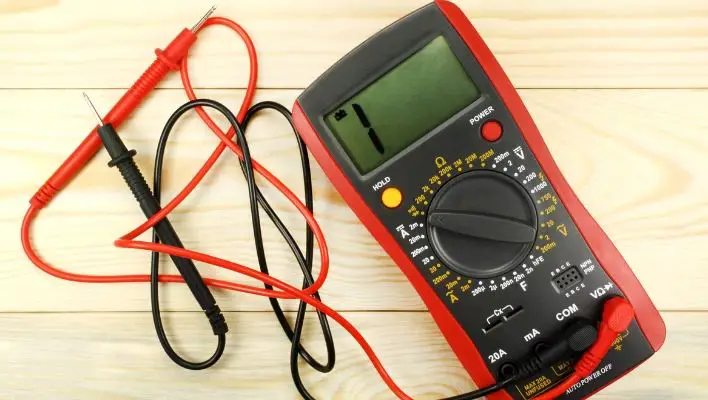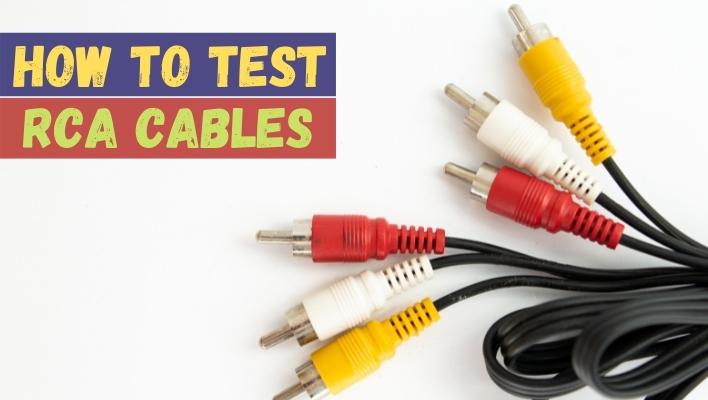If you are experiencing poor audio quality from your speakers, chances are your RCA cables are bad. However, before spending money on new cables, save yourself the hassle and learn how to test RCA cables.
In this article, we will discuss how to test RCA cables with a multimeter and without a multimeter. This way, you will be able to know if your cables are bad using different methods, such as using a phase tester or visual inspection. Let’s dive in!
What You Need to Know About RCA Cables
A Radio Corporation of America (RCA) is an electrical conductor that can carry video (AV) or audio signals from a radio or amplifier to the speaker. These cables date back to the early 1940s and are the oldest types of wires used today.
Also known as Av jacks or photo connectors, RCA cables have two plugs; male and female plugs. Though RCA cables come in different colors, the most common colors are white or black for the left-channel audio, red for the right-channel audio, and yellow cable for the video.
Since RCA cables are color-coded, they are very efficient, easy to use or install, and simple. These cables can be used to connect the audio and video parts of different devices, including TVs, gaming consoles, speakers, cable boxes, and more. If your RCA cables are bad, chances are that you will experience very poor audio quality.
In that case, it may be time to replace the cable. However, before investing money in new cables, you should consider testing your cables. This way, you will know if your cables are really bad or if there’s a problem with your speakers. Here’s how to test RCA cables.
How to Test RCA Cables with a Multimeter
One of the best ways of testing RCA cables is using a multimeter. This is a handheld tool that can be used to measure electrical properties such as resistance, gain of transistors, current, capacitance, frequency, and voltage.

A multimeter offers a combination of a voltmeter, an ammeter, and an ohmmeter. Since the device can work as individual test equipment, it is not limited to any measurements. You can troubleshoot both the shield and tip of your RCA cables using a digital multimeter.
The tip of the cable is the part that carries audio signals, and the shield protects the signal from any interference. These two parts play a key role in ensuring your RCA cable works as it should.
Testing the RCA Cable Tip
Here are the steps you should follow when testing the tip of the cable using a digital multimeter:
- Set the multimeter to continuity mode. This is indicated by a sound symbol on the device.
- Attach the black tip of the multimeter to one tip of the cable
- Touch or attach the red tip of the device to the other tip of the cable
You will know if the circuit is complete and the RCA cable is good if the multimeter beeps continuously. However, if the tool doesn’t beep, then your cable is bad, and you will have to replace it.
Testing the RCA Cable Shield
The other part of the cable that you should test is the shield. To do this, you should:
- Set the multimeter to continuity mode.
- Place one tip of the multimeter on the cable’s shield
- Place the other tip of the multimeter on the other shield
A continuous beeping sound from the tool is an indication the connection is good. Repeat this process for any other RCA cable you are using. If all your cables are good, then you need to consider troubleshooting the connections, amplifier, or speakers.
How to Test RCA Cables Without a Multimeter
Suppose you don’t have a multimeter. In that case, there are alternative methods you can use. Here are some ways to test RCA cables without a multimeter.
Visual Inspection
If you don’t have a multimeter, you can visually inspect your RCA cables for any damages. This method requires a keen eye and dedication. To inspect your cables:
- Carefully check the outer part of the cable for signs of damage, such as fraying or cracks.
- Secondly, check the ends of the cables, right where they connect to the plugs. Check if the shields and tips are loose or if they are tight and secure. Any loose component is an indication of a damaged cable.
Use a Phase Tester
A phase tester is a tool that sends signals through the RCA cables to test for continuity. If there is a signal traveling through the RCA cables, then your cables are okay. To test your RCA cables using a Phase tester, you will need an amp, the phase tester, and a female-female RCA plug. Here are the steps to follow:
- Peg the crocodile clips from the phase tester to the speaker posts.
- Plug the female plug into the RCA cable from the tester
- Connect one end of the RCA cables to the amp
- Connect the other end of the cables to the female plug. Do this one at a time as you listen out for a beep from the speaker. If theirs is no beep, your RCA cables are bad.

In some cases, the cables may be working, but the jacks are bad. In this case, you can also use a phase tester to test the RCA jacks. To do this:
- Hook the crocodile clips from the tester to the speaker post.
- Connect the cable from the tester to the RCA jacks on the amp. Connect one jack at a time.
- If there’s any sound from the speaker, in that case, your jacks are good, and vice versa. You will need to replace your RCA jacks immediately.
Switching Up the Cable and the Amp
The other method of testing the RCA cables without a multimeter is switching up the amp with another one. This is a quick and easy way of checking if the cables are bad without a multimeter. If the amp is working, then the cables can be the problem. To do this:
- Disconnect the RCA cables from the amp
- Connect another pair of RCA cables to the amp
- Power up the amp and check if the system is working. If the amp is working with another cable, then your previous cables are bad.

Wrapping Up
Though visual inspection, switching cables, and using a phase tester are all good ways of testing if RCA cables are working, the best way to test your cables is by using a multimeter. Therefore, before you replace your RCA cables, or buy a new amp or speakers, ensure you first test your RCA cables. Remember, when buying RCA connectors, choose high-quality connectors that are made from silver or copper. These connectors offer better conductivity than connectors made of gold.
You may also read: WASAPI vs ASIO- Which is the Best Audio Driver?
